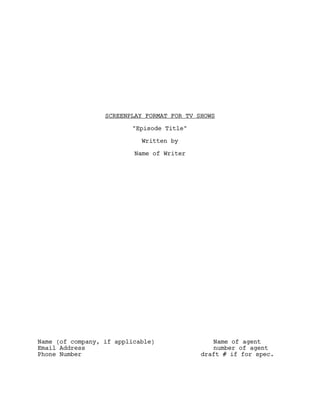Formato Serie TV
- 1. SCREENPLAY FORMAT FOR TV SHOWS "Episode Title" Written by Name of Writer Name (of company, if applicable) Name of agent Email Address number of agent Phone Number draft # if for spec.
- 2. SERIES TITLE "Episode Title" TEASER FADE IN: EXT. LOCATION #1 - DAY Action goes here. INT. LOCATION #2 - NIGHT More action goes here. CHARACTER #1 Hi, Iâm Character #1. CHARACTER #2 And Iâm Character #2. CHARACTER #2 (CONT'D) (pause) I just paused. CHARACTER #1 (beat) I just took a beat. If scene action interrupts a character's speech on the same page... CHARACTER #1 (CONT'D) Now Iâm talking again. End the Teaser and each Act like this. FADE OUT. END OF TEASER
- 3. 2. ACT ONE FADE IN: EXT. LOCATION #1 - NIGHT Hereâs how dual-dialogue looks. CHARACTER #1 CHARACTER #2 Dialogue here. More dialogue here. CHARACTER #2 And even more dialogue here. EXT. LOCATION #2 - NIGHT Hereâs how the Beeb does foreign languages. CHARACTER #1 (in French) Indicate the language in parens and write the dialogue in English. CHARACTER #2 (in Spanish; English subtitles) If your character is speaking in a foreign language with subtitles, itâs written like this. If the whole scene is being spoken in a foreign language, make a note of this in the scene action, like this. NOTE: THE DIALOGUE IN THIS SCENE IS SPOKEN IN WELSH AND SUBTITLED IN ENGLISH. CHARACTER #1 Then just write the dialogue in English. CHARACTER #2 Let the reader know with a note that the subtitles have ended. END OF SUBTITLES. INT. LOCATION #2 - DAY Action here. DISSOLVE TO: SERIES OF SHOTS:
- 4. 3. A) SERIES OF SHOTS: This is the first shot. B) This is the second shot. C) MONTAGE: another series of shots. EXT. LOCATION #1 - NIGHT Action here. FADE OUT. END OF ACT ONE
- 5. 4. ACT TWO FADE IN: EXT. LOCATION #2 - NIGHT Hereâs where the second act begins. CHARACTER #1 (O.S.) Dialogue here. CHARACTER #2 (V.O.) Dialogue here. CHARACTER #2 Dialogue here. INTERCUT - INT. LOCATION #1/LOCATION #2 - DAY Hereâs how intercut scenes are handled. CHARACTER #1 (into phone) Dialogue here. CHARACTER #2 (into phone) Dialogue here. CHARACTER #1 (into phone) Dialogue here. (hangs up) Dialogue here. INT. LOCATION #1 - DAY You can also establish both locations separately. CHARACTER #1 (into phone) Dialogue here. INT. LOCATION #2 - DAY Then establish your next location. CHARACTER #2 (into phone) Dialogue here. INTERCUT:
- 6. 5. CHARACTER #1 (into phone) Dialogue here. CHARACTER #2 (hangs up) Dialogue here. END OF ACT TWO
- 7. 6. ACT THREE FADE IN: EXT. LOCATION #2 - NIGHT On-screen text, such as letters, e-mails, or signs, are formatted in a couple of ways. Brief text, such as a sign, can go in the body of the scene action: "THIS IS A SIGN" "Something longer, like a letter, is formatted like dialogue enclosed within double-quote marks. It can be in normal upper and lower case text, OR ALL IN CAPITALS depending on the text it is representing." END OF ACT THREE
- 8. 7. ACT FOUR FADE IN: EXT. LOCATION #2 - NIGHT On-screen text, such as letters, e-mails, or signs, are formatted in a couple of ways. Brief text, such as a sign, can go in the body of the scene action: "THIS IS A SIGN" "Something longer, like a letter, is formatted like dialogue enclosed within double-quote marks. It can be in normal upper and lower case text, OR ALL IN CAPITALS depending on the text it is representing." END OF ACT FOUR
- 9. 8. TAG FADE IN: EXT. LOCATION #2 - NIGHT On-screen text, such as letters, e-mails, or signs, are formatted in a couple of ways. Brief text, such as a sign, can go in the body of the scene action: "THIS IS A SIGN" "Something longer, like a letter, is formatted like dialogue enclosed within double-quote marks. It can be in normal upper and lower case text, OR ALL IN CAPITALS depending on the text it is representing." END OF SHOW.








